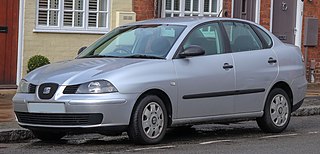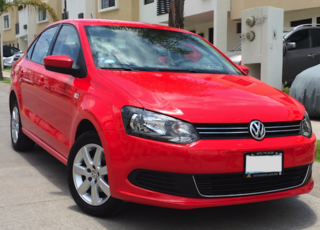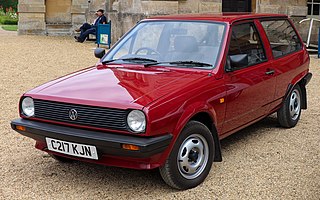
The Volkswagen Golf is a compact car/small family car (C-segment) produced by the German automotive manufacturer Volkswagen since 1974, marketed worldwide across eight generations, in various body configurations and under various nameplates – including as the Volkswagen Rabbit in the United States and Canada, and as the Volkswagen Caribe in Mexico (Mk1).

The Volkswagen Polo is a supermini car (B-segment) produced by the German car manufacturer Volkswagen since 1975. It is sold in Europe and other markets worldwide in hatchback, saloon, and estate variants throughout its production run.

The SEAT Ibiza is a supermini car that has been manufactured by Spanish car manufacturer SEAT since 1984. It is SEAT's best-selling car. The Ibiza is named after the Spanish island of Ibiza and was the second SEAT model to be named after a Spanish location, after the SEAT Málaga. It was introduced at the 1984 Paris Motor Show as the first car developed by SEAT as an independent company, although it was designed by SEAT in collaboration with well-known firms including Italdesign, Karmann, and Porsche.

The Volkswagen Lupo is a city car that was produced by the German car manufacturer Volkswagen, from 1998 to 2005. It shares most of its aspects with the Volkswagen Group's SEAT Arosa, both derived from the Volkswagen Polo Mk3 platform. Main differences are found in styling and equipment. The Lupo name is Latin, meaning wolf, and is named after its home town of Wolfsburg.

The Volkswagen Passat is a nameplate of large family cars (D-segment) manufactured and marketed by the German automobile manufacturer Volkswagen since 1973. It has been marketed variously as the Dasher, Santana, Quantum, Magotan, Corsar and Carat, with varying body styles such as saloon, estate, and hatchback.

The Rover 200 Series, and later the Rover 25, are a series of small family cars that were produced by British manufacturer Rover from 1984 until 2005.

The Škoda Fabia is a series of passenger cars produced by Czech manufacturer Škoda Auto since 1999. It is the successor of the Škoda Felicia, which was discontinued in 2001. The Fabia was available in hatchback, estate and saloon body styles at launch, and from 2007, the second generation was offered in hatchback and estate versions. The third generation Fabia was launched in 2015, and the fourth in 2021.

The SEAT Córdoba is the saloon, estate and coupé version of the SEAT Ibiza supermini car, built by the Spanish automaker SEAT. It was manufactured between 1993 and 2008, and was related to the second and third generations of the Ibiza.

The Volkswagen Vento is a subcompact car produced by the Volkswagen India and Volkswagen Russia subsidiaries of the German manufacturer Volkswagen since 2010. It is essentially a three-box Volkswagen Polo with a stretched wheelbase and has been developed especially for some markets. The car is sold under the Vento nameplate in India, Malaysia, Brunei and Mexico. In Thailand, South Africa, Argentina, Russia, Jordan, Morocco, Algeria, Tunisia and the Middle East, it is sold as the Volkswagen Polo Sedan. The name Vento means 'wind' in both Italian and Portuguese. It is also known as the Volkswagen Polo Notch in the Philippines.

Volkswagen Derby was the name first given by German automaker Volkswagen for the commercialization of the booted saloon (three-box) version of its Volkswagen Polo Mk1 supermini, between 1977 and 1981 in Europe. Later, the Derby name was used by the Mexican Volkswagen subsidiary for the Polo Classic Mk3 saloon on its domestic market in the mid-1990s.

The Volkswagen Polo Mk4 is the fourth generation of the Volkswagen Polo supermini car produced by the German manufacturer Volkswagen. It was marketed from early 2002 to 2010 in most countries except Argentina and the USA. It was manufactured in South Africa until 2017, it was sold as the Polo Vivo. The Mk4 replaced the Volkswagen Polo Mk3, while the Polo Vivo replaced the Citi Golf. In 2018 the Mk4 was replaced by the Volkswagen Polo Mk5 Polo Vivo. In Brazil, It was manufactured until 2014 with a second facelift called 9n4, It was replaced in 2017 by Volkswagen Polo Mk6.

The Volkswagen Polo Mk2 is the second generation of the Volkswagen Polo supermini. It was produced from late 1981 until 1994. It received a major facelift in 1990 and was available in three different body styles, including a distinctive kammback-styled hatchback, nicknamed "breadvan" in the UK but referred to as a Steilheck in Germany. The sedan version typically received the name of Volkswagen Derby.

The Volkswagen Polo Mk1 is the first generation of the Volkswagen Polo supermini. It was produced from 1975 until 1981.
1994 in motoring includes developments in the automotive industry that occurred throughout the year 1994 by various automobile manufacturers, grouped by country. The automotive industry designs, develops, manufactures, markets, and sells motor vehicles.

The Volkswagen Golf Mk5 is a compact car/small family car manufactured and marketed by Volkswagen, as the fifth generation of the Golf in three- or five-door hatchback and a five-door station wagon (2007–2009) configurations, as well as the successor to the Golf Mk4. Using the Volkswagen Group A5 (PQ35) platform, the Mk5 debuted at the Frankfurt Motor Show in October 2003 and went on sale in Europe for the 2004 model year. While marketed as the Volkswagen Rabbit in the United States and Canada, the GTI model in these countries was marketed simply as the Volkswagen GTI.

The Volkswagen Golf Mk4 is a compact car, the fourth generation of the Volkswagen Golf and the successor to the Volkswagen Golf Mk3. Launched in October 1997 for the 1998 model year, it was the best selling car in Europe in 2001.

The Volkswagen Golf Mk3 is a medium-sized compact family car. It's the third generation of the Volkswagen Golf and the successor to the Volkswagen Golf Mk2, which was produced by Volkswagen from August 1991 to 2002.

The Volkswagen Golf Mk2 is a hatchback, the second generation of the Volkswagen Golf and the successor to the Volkswagen Golf Mk1. It was Volkswagen's highest volume seller from 1983 and ended in (German) production in late 1992, to be replaced by the Volkswagen Golf Mk3. The Mk2 was larger than the Mk1; its wheelbase grew slightly, as did exterior dimensions. Weight was up accordingly by about 120 kg (260 lb). Exterior design, developed in-house by VW design director Schäfer, kept the general lines of its Giugiaro-designed predecessor, but was slightly more rounded. All told, about 6.3 million second-generation Golfs were built.

The EA827 family of petrol engines was initially developed by Audi under Ludwig Kraus leadership and introduced in 1972 by the B1-series Audi 80, and went on to power many Volkswagen Group models. This is a very robust water-cooled engine configuration for four- up to eight- cylinders. In Brazil this engine was produced under the name Volkswagen AP AP.

The Volkswagen Polo Mk5 is the fifth generation of the Polo, a supermini-class car manufactured by Volkswagen since 2009. The vehicle unveiled at the 2009 Geneva Motor Show in March 2009, while the three-door version was unveiled at the 2009 Frankfurt Motor Show in September 2009. A four-door long-wheelbase sedan version has been produced and sold outside Europe in several emerging markets since 2010 either as the Volkswagen Vento or the Volkswagen Polo sedan. A short-wheelbase sedan version was sold in India between 2016 and 2020 as the Volkswagen Ameo.






























